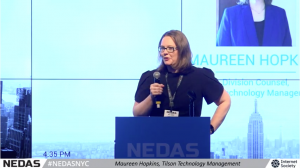 When it comes to bringing wireless deployments to fruition in the era of 5G densification, the many types of legislation and preferences of every unique state, jurisdiction or municipality make every siting endeavor different. While the success of a diverse array of projects across a wide range of geographic areas necessitates flexibility, if the legal foundation of the process and the best practices are clear, then barriers to deployment can come down easily.
When it comes to bringing wireless deployments to fruition in the era of 5G densification, the many types of legislation and preferences of every unique state, jurisdiction or municipality make every siting endeavor different. While the success of a diverse array of projects across a wide range of geographic areas necessitates flexibility, if the legal foundation of the process and the best practices are clear, then barriers to deployment can come down easily.
To explore this topic, the 2019 NEDAS NYC Summit, an event focusing on discussion and education at the intersection of wireline and wireless, offered a presentation from Maureen Hopkins, Division Counsel, Tilson Technology Management. The presentation, titled Siting/Land-Use for DAS & Small Cell, explored what steps can be taken to make successful advancements in wireless infrastructure siting and deployments.
As far as the legal framework element of the process goes, there are three tiers of regulation that need to be addressed: federal, state and local law. In the federal realm, there exists the Telecommunications Act, NEPA (National Environmental Policy Act), FCC (Federal Communications Council) Reports and Orders and beyond. One key element to recognize in this area is that terms are important. Hopkins notes that in order to invoke the legal protections under state and federal laws, it is critical to ensure that the language used in agreements matches that contained in the laws.
On the state level, the industry is seeing a lot of states implementing their own small wireless siting acts on top of local municipal ordinances. To date, 29 states have enacted Small Wireless Facilities (SWF) legislation, and several others have legislation pending or in the works. These pose varying degrees of usefulness to deployment. Middle states tend to be particularly favorable for wireless carriers. For instance, Oklahoma offers a provision that prohibits a jurisdiction from collecting more than $20 dollars per year per facility, which is significantly less than the $270 that can often be seen at the federal level.
At the municipal tier, some municipalities have adopted SWF ordinances that work with state and federal laws, and some have no applicable ordinances at all. A lot of towns have just not put a lot of thought into wireless deployment or how they want to approach it, which can pose challenges for siting and deployment.
Overall, best practices include smart siting decisions. This covers actions such as putting a pole on a property line or a corner, not in front of someone’s window. Along the same vein, aesthetic sensitivities promote successful deployment in municipalities as well. Additionally, as Hopkins states, the law should be used “as a shield, not a sword.” This means that demanding decisions within a certain timeframe just because the law may require it may not lend itself to success in the way that a more patient or collaborative approach with local personnel would. At the end of the day, if sensitivities to foundational laws and preferential best practices are maintained, the process will remain relatively smooth.
To get a more in-depth look at this topic, please click here to view the entire panel presentation.
To learn more about NEDAS, please visit www.nedas.com.





